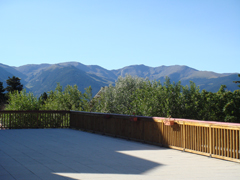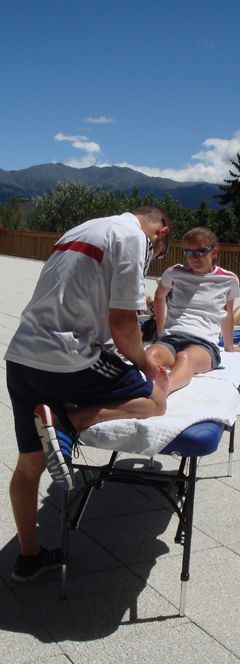
As it is, I woke up this morning & went to my office for the week...I couldn't help but smile as the view that met my eyes was one to behold.
Don't get me wrong, I worked my butt off, was flat out until about 18.30 & when the last athlete walked out of the door, my hands & thumbs were aching. But the athletes out here are great fun, have good chat & enjoy working hard at what they do, so it certainly helps pass the time!!
This is the first time I have worked on an endurance camp & the obvious differences are that the exercise physiologist plays a much greater role in the training evaluation & programming than would happen with say a sprinter or a jumper, the hours that the athletes are out training are far greater & the recovery they need particularly at altitude needs to be more closely monitored..
From a physiotherapy perspective, what I have noticed is the prevalence of foot & ankle issues is far greater, whilst the influence the foot & ankle has on the more proximal structures is also greater than I see in a sprint population. The miles that these guys put in, over rocky, rooted paths, in fatigued states must play it's part & gives rise to prolific reporting of acute & chronic recurrent ankle sprains. On assessment, I have seen marked changes in peroneii, tibialis anterior, tibialis posterior & triceps surae characteristics which are obviously contributing to a wide range of the clinical presentations coming through my door.
So reflecting on my days to date, I figured I should recap the major points I remember from the research I have read in the past & they are as follows:
Arthrogenic inhibition of the peroneal musculature & reduced peroneal muscle activation is widely reported following lateral ankle sprain but there is great debate between papers as to whether this has a direct effect on functional ankle instability. It is argued that deficits in eccentric invertor strength are likely to contribute because of a reduced ability to assist in the control of the lateral displacement of the shank over the weight-bearing foot.
Some authors suggest that reduced eccentric plantar-flexor torque is far more influential, suggesting that this occurs either at the time of injury with trauma occurring at the gastroc/soleus complex as it crosses the talo-crural joint, or post-injury due to reduced motor unit excitability & arthrogenic inhibition of the soleus post injury affecting the plantar-flexion torque production.
The tibialis posterior is also be the victim of arthrogenic inhibition & it's roles in stabilising the tarsus as well as maintaining balance are subsequently compromised.
Patients post-ankle sprain demonstrate a higher incidence of having a posteriorly positioned fibula than control groups
Comparison between uninjured & injured sides with regards strength, power & proprioception should not be a powerful indicating factor in determining positive research findings, as numerous studies have shown that the cross-over effect will influence ipsilateral & contralateral joints respectively & even influence joints far more proximal than the ankle.
Likewise much of the research has been done considering walking gait as opposed to running gait & as such cannot be directly applied to the athletic performance population with regards sport-specific task performance.
However, given that I have had some time after supper this evening, I took the opportunity to go back & look through some of the papers I have on my hard drive that discuss the topic. Not all of them - there aren't enough hours in a day never mind an evening & many I only have on hard copy, but here are the ones I have managed to browse through & feel free to click on the links to review them for yourself:
Kaminski & Hartsell (2002) Factors Contributing to Chronic Ankle Instability: A Strength Perspective
Palmieri-Smith et al (2009) In Patients with FAI Following a Lateral Ankle Ligament Sprain, There is Evidence of Arthrogenic Inhibition in the Peroneal Musculature as Well as Reduced Dynamic Peroneal Muscle Activation
I hope you find them of some use!

